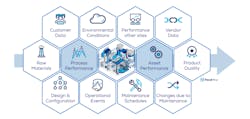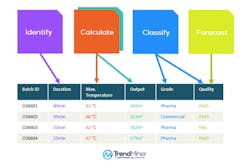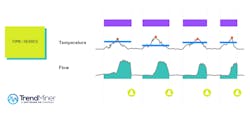As smart factories have transformed the manufacturing floor, they also have redefined the boundaries of traditional chemical processing plants. Remote workforces, advancements in cloud technology and a need for strong security protocols have led to the storage of operational data in the cloud. This shift away from a traditional, on-premises historian to a modern historian database—or cloud storage of time-series data—has allowed companies to expand data access and enabled more people to make data-driven decisions.
Breaking Down Data Silos
Improved accessibility makes operational visibility easier, so process engineers can make data-driven decisions even when they are not on the factory floor. By migrating existing historians to the cloud or adopting hybrid environments, manufacturers can blend on-premises infrastructure with cloud solutions and advanced analytics software can be rolled out faster. Indeed, Clariant AG was able to deploy up to 30% faster when compared to traditional methods.
“As part of our digital strategy, we adopted a cloud-first approach to store our industrial data,” says Nimet Sterneberg, a data scientist with a chemical engineering background at Clariant. “Moving away from an on-premises historian allowed us to connect 20 additional plants to the cloud and apply advanced industrial analytics to more operational data. As a result, hundreds of our workers were given the opportunity to use the unified data in their daily decision-making.”
Additionally, cloud services offer the ability to quickly scale up or down, which allows companies to adapt to changing operational needs and efficiently manage resource allocation.
Empowering Data Insights
Cloud services offer analytics solutions, which include statistical analysis, machine learning and artificial intelligence. However, these services require advanced knowledge and the ability to design a solution that will fit a company’s analytics needs. In contrast, applying advanced industrial analytics software to data in the cloud allows operational experts to use all the data without the need to create data models. With this self-service approach, process engineers can identify inefficiencies, predict maintenance needs and detect anomalies that may indicate potential issues in the manufacturing process. These insights enable proactive decision-making and prompt interventions to optimize operations, which in turn minimizes downtime.
At a Bayer Crop Science plant in Dormagen, Germany, production capacity increased by almost 10% by systematically analyzing and solving problems with the support of advanced industrial analytics applied to data stored in the cloud.
“In the reactor, we had a problem with the generation of a viscous phase during the addition of the starting material,” says Marita Beyer-Weitkus, the plant manager in Dormagen. “The viscous phase is caused by an intermediate product that, when it precipitates, forms a creamy, sticky mass, which looks like whipped cream. When you have this effect, you can add the remaining amount only very slowly and, at the end of the day, this reduces production output.
“Using a reporting system that checks overall equipment efficiency, it was possible to identify the process step where the delays occurred,” she says. “Then, using advanced industrial analytics software, a deeper analysis of this process step was carried out, and the reason for the problem was found. These insights were evaluated together with experts from process development, and measures were developed to eliminate the problem.”
For a deeper understanding of factors influencing process behavior, chemical processors can contextualize operational data by incorporating information from other third-party business applications, as shown in Figure 1. For instance, combining operational data with weather reports can help identify correlations between environmental conditions and production inefficiencies. Similarly, incorporating maintenance schedules and planned downtime information allows for accurate differentiation between planned and unplanned downtime events. This information can be used to set up monitors and alerts for unplanned events that allow key stakeholders to make corrections in a timely manner.
Collaborating With Central Teams
At times, local experts will require the assistance of central data teams to collaborate on a data science exercise. This could include creating machine learning models to forecast critical process parameters, identify anomalies and improve the overall efficiency of operations. Providing both groups with a unified data source in the cloud helps facilitate this collaboration. By working together, process engineers can provide valuable domain knowledge and insights into the intricacies of the manufacturing process, while data scientists contribute their expertise in statistics and math.
“What we do is get the data from the cloud and import it into the advanced industrial analytics software,” explains Clariant’s Sterneberg. “We then gather the time-series data from there and use our own algorithms and our own data science platform, where we then derive analytics from it, discuss the results and get opinions for the next steps. Closing the gap between engineers and data scientists such as myself brings us into the loop so we can work with our end users to do the analysis together. This is where we started to use the machine learning capabilities of advanced industrial analytics at Clariant.”
Considerations for the Cloud
Cloud solutions can work in tandem with on-premises historians, so chemical processors do not necessarily have to move all their data to the cloud at once. Another option is to convert the data structure of existing historians from on-premises to cloud-based architecture, which can vary depending on the service provider, such as AWS or Azure. Existing historian and third-party data can then be migrated into the cloud.
While advantages of moving to the cloud include lower cost, greater scalability and opportunities to analyze more data, there are some considerations. Companies lose some control over their data when they move it to the cloud. Despite greater access to data, access time also might be longer. For example, searching for data for use in compliance and reporting to adhere to regulations, such as HIPPA or GDPR, can take more time when it is stored in the cloud. However, cloud vendors typically cover a portion of the cost to ensure their architecture meets regulatory requirements.
Another concern is data security. In an on-premises solution, ensuring that data remains secure falls on the shoulders of the corporate IT Security team. In the cloud, data security depends on the vendor. Some offer more responsibility for customers’ data than others. Those with more shared responsibilities can pose a burden on a corporate IT Security team when there are more data warehouses to protect. Still, cloud providers typically offer high-security capabilities, and the cost generally is lower.
Conclusion
A cloud-first strategy provides a global architecture for collaboration, knowledge-sharing, remote monitoring and leveraging the help of experts.
The combination of operational visibility, collaboration and continuous improvement of cloud-first solutions with advanced industrial analytics software empowers chemical process engineers to drive operational excellence.






